
Mastering Commands and Instructions: The Power of Imperative Verbs Worksheets
In the intricate tapestry of language, verbs serve as the dynamic threads, weaving actions and states of being into meaningful expressions. Among these, imperative verbs hold a unique and profoundly practical position. They are the direct calls to action, the crisp instructions, the polite requests, and the urgent commands that permeate our daily communication. From a simple "Stop!" to a detailed recipe or a set of driving directions, imperative verbs are fundamental to conveying direct action and guiding behavior. For language learners, grasping the nuances and correct usage of these verbs is not merely a grammatical exercise; it’s a vital step towards effective, real-world communication. This is where imperative verbs worksheets emerge as an indispensable pedagogical tool, offering structured practice and reinforcement.
This comprehensive article will delve into the essence of imperative verbs, explore why imperative verbs worksheets are so crucial for language acquisition across various proficiency levels, and provide insights into designing and utilizing them for maximum educational impact.
The Essence of Imperative Verbs: A Direct Call to Action
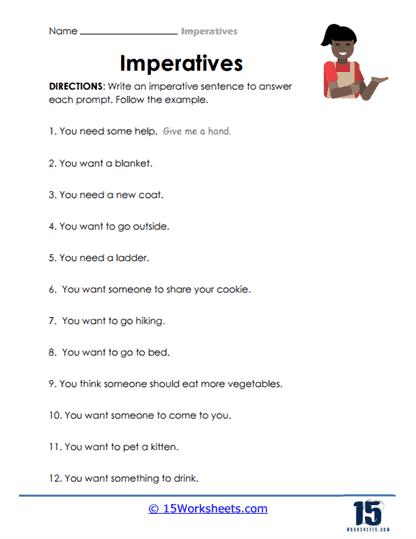
At its core, an imperative verb is a verb that gives a command, makes a request, offers instructions, or provides advice. What distinguishes it grammatically is the implied subject "you." Unlike most sentences that explicitly state who is performing the action (e.g., "She runs," "They learn"), imperative sentences directly address the listener or reader, expecting them to be the one to carry out the verb’s action.
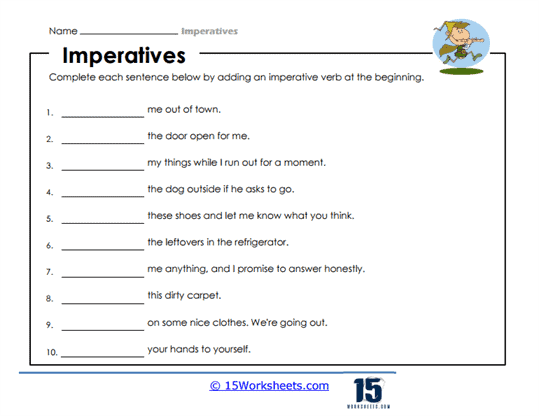
Consider these examples:

- Command: "Close the door!"
- Request: "Please pass the salt."
- Instruction: "First, mix the ingredients thoroughly."
- Advice: "Always look both ways before crossing the street."

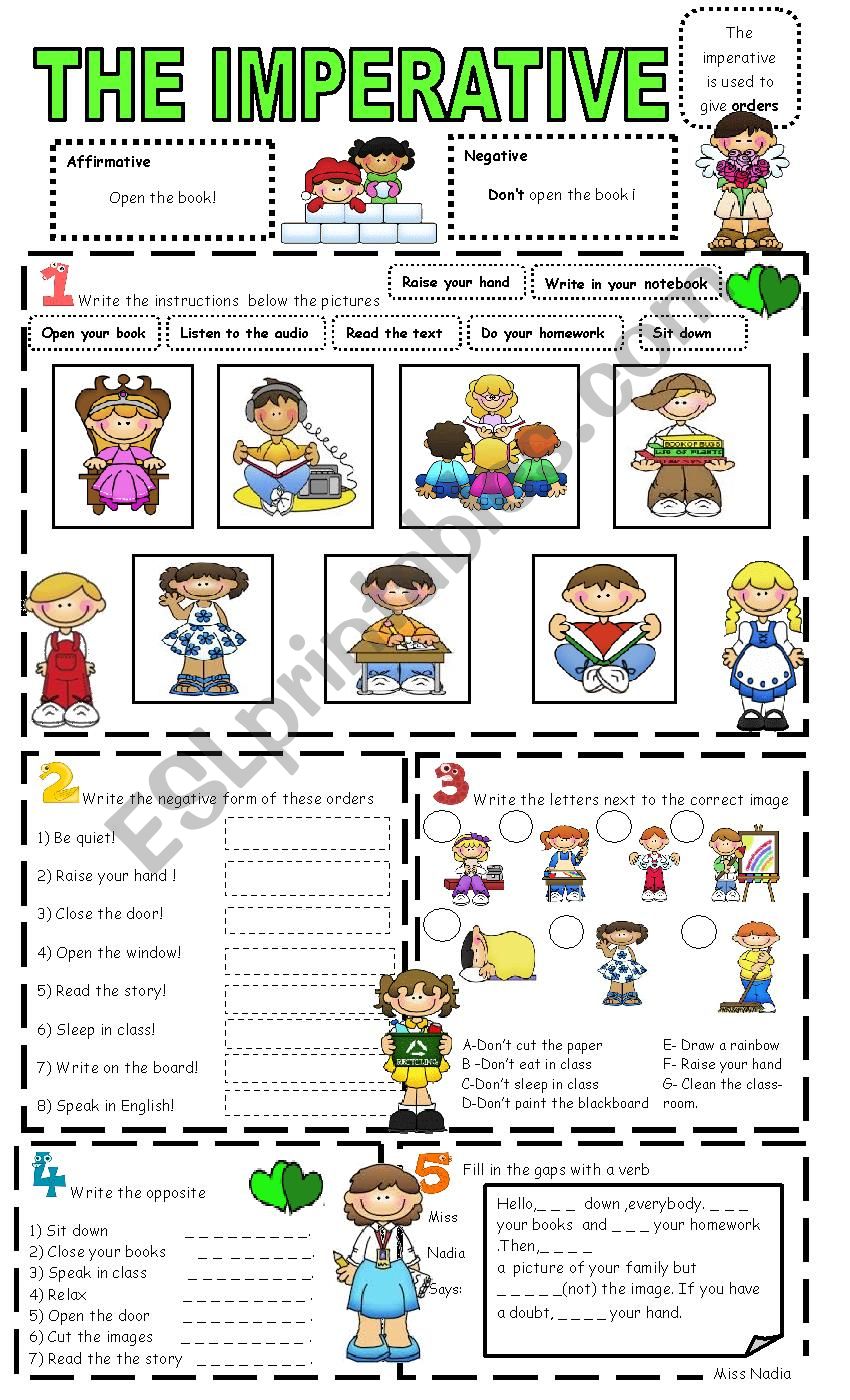
Imperative verbs typically appear in their base form (infinitive without "to"), and they can be positive ("Go!") or negative ("Don’t go!"). Understanding this fundamental structure is the first step, but truly mastering their application requires extensive, contextualized practice – precisely what well-designed imperative verbs worksheets provide.

Why Imperative Verbs Worksheets are Indispensable for Language Learning
The journey to linguistic proficiency is paved with deliberate practice, and in the realm of direct communication, well-crafted imperative verbs worksheets serve as indispensable guides. Their value stems from several key benefits:

- Targeted Practice: Worksheets allow educators to isolate specific grammatical concepts. Instead of overwhelming learners with a multitude of grammatical rules, worksheets focus squarely on the form, function, and application of imperative verbs, ensuring concentrated learning.
- Reinforcement and Repetition: Language acquisition thrives on repetition. Worksheets offer multiple opportunities to encounter, identify, and construct sentences using imperative verbs, solidifying understanding and promoting retention.
- Active Learning: Unlike passive listening or reading, completing a worksheet requires active engagement. Learners must recall rules, make decisions, and produce language, leading to deeper processing and understanding.
- Differentiation: Worksheets can be easily adapted to suit various learning styles and proficiency levels. A beginner might start with simple identification tasks, while advanced learners can tackle complex instruction writing or nuanced politeness practice.
- Assessment and Feedback: Worksheets provide tangible evidence of a learner’s understanding, allowing educators to identify areas of strength and weakness. This data is crucial for providing targeted feedback and adjusting teaching strategies.
- Real-World Relevance: Imperative verbs are not abstract grammatical constructs; they are integral to everyday life. Worksheets can simulate real-world scenarios, from giving directions to writing recipes, making the learning process more relatable and practical.
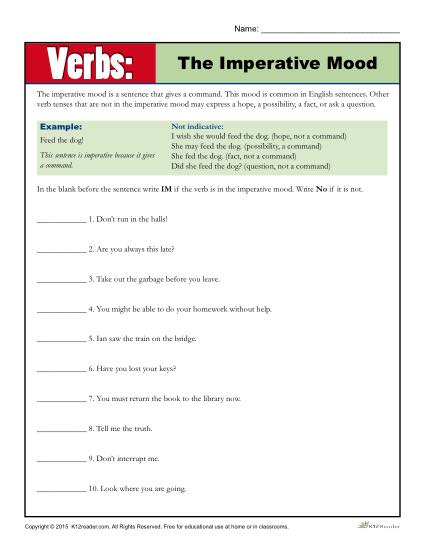
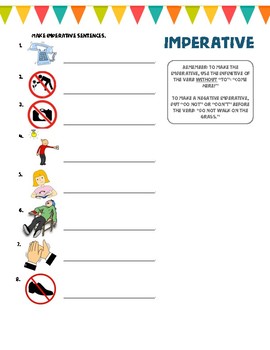
Designing Effective Imperative Verbs Worksheets
The thoughtful design and consistent application of imperative verbs worksheets are paramount to their effectiveness. A well-designed worksheet is more than just a series of questions; it’s a scaffolded learning experience. Here are principles to consider:
- Clarity and Simplicity: Instructions on the worksheet should be crystal clear. Use simple language and provide an example for each exercise type.
- Progression: Start with easier tasks (identification, matching) and gradually move towards more complex ones (sentence creation, writing instructions). This builds confidence and mastery.
- Variety of Exercise Types: Monotony breeds disengagement. Incorporate a mix of activities to keep learners interested and cater to different learning preferences.
- Contextualization: Present imperative verbs within meaningful contexts. Isolated sentences are less effective than those embedded in short dialogues, stories, or real-world scenarios.
- Visual Appeal: Use clear fonts, adequate spacing, and relevant images or diagrams, especially for younger learners or visual learners.
- Scaffolding: Provide support where needed, such as word banks for fill-in-the-blank exercises, sentence starters, or helpful hints.
Types of Activities for Imperative Verbs Worksheets
To maximize engagement and learning, a diverse range of activities should be incorporated into imperative verbs worksheets:
-
Identification Exercises:
- Underline/Circle the Imperative Verb: Given a list of sentences, learners identify the imperative verb.
- Identify Imperative Sentences: Given a mix of sentence types (declarative, interrogative, imperative), learners identify only the imperative ones.
-
Transformation Exercises:
- Declarative to Imperative: Learners transform a statement into a command or request (e.g., "You should sit down" becomes "Sit down!").
- Negative Imperatives: Learners transform positive imperatives into negative ones (e.g., "Run!" becomes "Don’t run!").
-
Sentence Completion/Fill-in-the-Blanks:
- Choose the Correct Verb: Learners select the most appropriate imperative verb from a word bank to complete a sentence (e.g., "___ the door, please." Options: open, runs, ate).
- Complete the Instructions: Given a set of steps for a task (e.g., making a sandwich), learners fill in the missing imperative verbs.
-
Matching Exercises:
- Verb to Picture/Situation: Learners match an imperative verb or sentence to a corresponding image or scenario (e.g., "Listen!" matched with a picture of ears).
- Command to Response: Learners match a command to an appropriate polite or direct response.
-
Sentence Creation/Writing Exercises:
- Write Commands for Pictures: Learners look at a series of pictures and write appropriate commands or instructions for each.
- Recipe/Instruction Writing: Learners write a short recipe, directions to a place, or instructions for a simple task, focusing on using imperative verbs.
- Dialogue Completion: Learners complete a dialogue by adding appropriate imperative requests or commands.
- Advice Giving: Learners write advice for a given problem using imperative verbs (e.g., "You have trouble sleeping. Write advice: ‘Try to relax before bed.’").
-
Role-Playing Scenarios:
- While not strictly a worksheet activity, worksheets can set up scenarios for role-playing where learners must use imperatives (e.g., "You are a doctor; give instructions to your patient," or "You are a tour guide; give directions.").
-
Politeness and Nuance:
- Adding "Please" and "Kindly": Worksheets can focus on transforming direct commands into polite requests by adding politeness markers.
- Formal vs. Informal: For more advanced learners, explore the appropriate use of imperatives in formal versus informal contexts.
Tailoring Imperative Verbs Worksheets to Different Learning Levels
The effectiveness of imperative verbs worksheets is greatly enhanced when they are tailored to the specific proficiency level of the learners:
-
Elementary/Beginner Learners:
- Focus on common, high-frequency imperative verbs.
- Heavily rely on visual aids (pictures, drawings).
- Activities should be simple: identification, matching, and short fill-in-the-blanks.
- Incorporate games or playful elements.
- Emphasis on basic commands for classroom management: "Sit down," "Listen," "Open your book."
-
Intermediate Learners:
- Introduce more complex instructions and multi-step commands.
- Practice negative imperatives ("Don’t touch").
- Focus on polite requests using "please," "kindly," or modal verbs like "Could you…?" (which are technically requests but often taught alongside imperatives due to similar function).
- Activities can include writing short sets of instructions (e.g., "How to make a simple craft"), completing dialogues, and transformation exercises.
-
Advanced Learners/Adult ESL:
- Explore the nuances of imperative use, including implied subjects and context-dependent meaning.
- Focus on formal vs. informal imperatives.
- Activities can involve writing detailed procedural texts (e.g., user manuals, safety guidelines), analyzing imperative use in literature or news articles, and engaging in debates or discussions where directives are necessary.
- Introduce "Let’s" as a form of inclusive imperative ("Let’s go to the park").
Integrating Technology with Imperative Verbs Worksheets
In the digital age, the concept of a "worksheet" has expanded beyond paper. Digital tools offer interactive and dynamic ways to practice imperative verbs:
- Interactive PDFs: Many platforms allow creating fillable PDFs where learners can type answers directly.
- Online Quiz Platforms: Websites like Quizlet, Kahoot, or Google Forms can be used to create quizzes on imperative verb identification, matching, or sentence completion.
- Educational Apps: Numerous language learning apps incorporate exercises for imperative verbs, often with gamified elements.
- Digital Task Cards: Platforms like Boom Cards allow for self-checking, interactive digital task cards focusing on specific grammar points.
- Video Prompts: Show a short video clip and ask learners to write down all the imperative commands or instructions they hear, or to write instructions for an action they observe.
Assessment and Feedback
Worksheets are not just for practice; they are also valuable assessment tools.
- Formative Assessment: Use worksheets to gauge understanding during a lesson, identifying areas where further instruction is needed.
- Summative Assessment: A well-designed worksheet can serve as a short quiz or test to evaluate mastery of imperative verbs.
- Feedback: Provide constructive feedback, highlighting correct usage and explaining errors. Encourage self-correction and peer correction.
- Rubrics: For writing tasks involving imperative verbs (e.g., writing instructions), use a rubric that assesses accuracy, clarity, and appropriate use of imperatives.
Conclusion
Imperative verbs are the backbone of direct communication, enabling us to give commands, make requests, offer instructions, and provide guidance in countless daily interactions. For language learners, mastering these verbs is not just about grammatical correctness; it’s about gaining the confidence and ability to navigate real-world situations effectively. Imperative verbs worksheets, when thoughtfully designed and strategically implemented, are an indispensable resource in this learning journey. They provide the targeted, repetitive, and contextualized practice necessary to transform abstract grammatical rules into fluent, practical communication skills. By embracing the power of these worksheets, educators can equip learners with a fundamental tool for clear, concise, and impactful expression, paving the way for greater linguistic proficiency and confidence.
